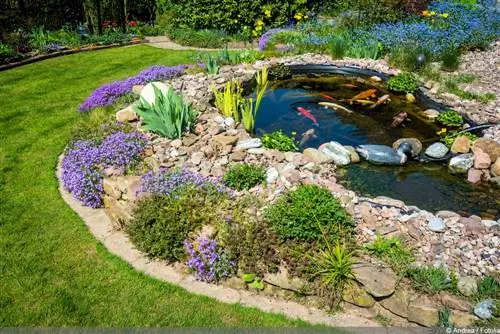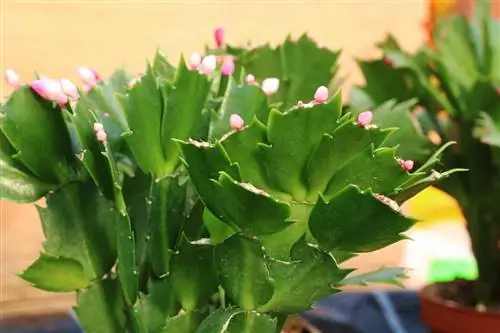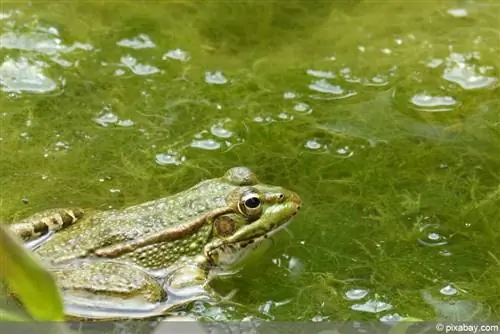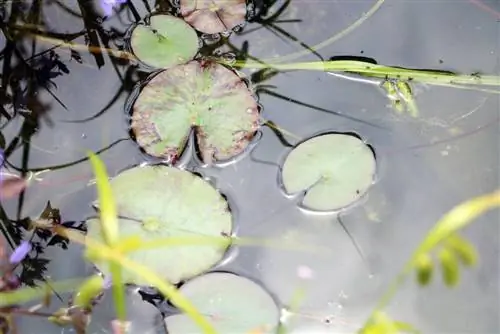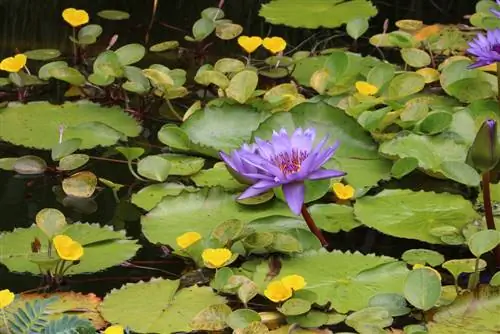- Author admin [email protected].
- Public 2023-12-17 03:39.
- Last modified 2025-01-24 12:45.
It is completely normal for a garden pond to lose water through evaporation in summer. However, if the water level drops rapidly, especially at night and in cool weather, action is necessary. Every garden owner's nightmare is a leaky pond. But fortunately, the suspicion of a defective pond liner is rarely confirmed. There are usually other reasons why the pond loses water.
How much water loss is normal?
If the water level drops slightly on a hot summer day, this is completely normal. This is largely due to the higher amount of evaporation, but also partly to the increased water requirements of the plants in the shallow water and wet zone areas of the garden pond. However, it is very difficult to make a statement about the exact amount of evaporation per day. After all, evaporation depends on many different factors.
In general, however, one can say that the water level can drop by around two centimeters per day in summer without there being anything to worry about. You can compensate for this water loss by occasionally topping up with fresh water. It is important to fill up very slowly so that the fish do not suffer thermal shock from the cold tap water.
Causes of greater water loss
If the garden pond loses large amounts of water per day - and perhaps not even in summer - evaporation cannot be the cause. In this case, it is necessary to act systematically to find out the cause. Depending on the season, the reasons may vary. In summer or autumn, a falling water level is often due to too dense water and bank vegetation.
Capillary effect
Garden pond owners often assume that the pond liner has a hole if the pond is losing a lot of water. The most common cause of this, however, is an inadequately created capillary barrier. Earth, stones or even plant roots can act like a wick in the bank area and suck the water out of the pond. In order to prevent this not insignificant capillary effect, a capillary barrier is placed at the edge of the pond.
Capillary barrier
A capillary barrier represents a barrier between the body of water and its surroundings. On the one hand, it prevents water from being withdrawn from the garden pond. At the same time, it prevents soil or fertilizer from entering the pond, which would cause over-fertilization. Your first attention should therefore be on the edge of the pond. Check this meter by meter and eliminate the cause:
- Roots of riparian plants
- Fleece or shore mat (must not extend beyond the pond liner)
- Lowering in the area under the capillary barrier
- moved pond liner
Subsequent installation
If you have neglected to install a capillary barrier, it may be possible to install it later. If there are panels or wood attached to the edge of the pond, the film is simply screwed onto the planks. If the pond liner ends on the lawn or a vegetated area, a small trench is dug all around it parallel to the edge of the pond. This only needs to be about 20 centimeters deep and wide. Line the trench with the foil and guide it into the ground behind it. The pond liner must be around 50 cm wider than the actual pond. You have various options for the system:
- Ditch with gravel fill
- Trench with lean concrete and slabs for covering
- System with multiple plates or blocks
Tip:
If the pond liner is not large enough, you can use a prefabricated edge system made of profiles about 20 centimeters high to prevent the capillary effect. The profiles are available by the meter with matching posts.
Hoses and technical connections
If the bank area is dry, next check the filter system. Leaky connectors, hoses or filter housings can also be to blame for water loss from the garden pond. Fill up the pond water and turn off the pump. If the water level remains constant over the next few days, a leak in the filter system is likely. You then have to take a closer look at these and replace defective parts.
Foil
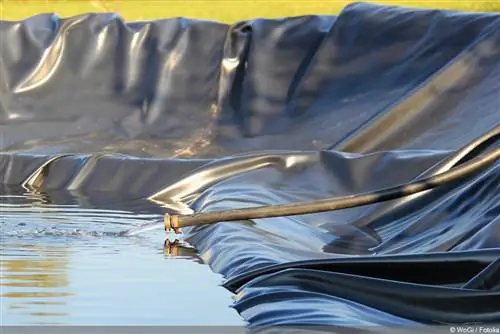
If all other causes have been ruled out, you must assume that the leak is within the pond and that the pond liner has leaked somewhere. Finding the leak is much more time-consuming than repairing it.
Find a leak
To make the search easier, first fill the garden pond up to the edge with fresh water and turn off all pumps. Check the water level every day and mark it on the pond liner. As soon as the loss decreases significantly or even comes to a complete standstill, the height of the crack or hole has been reached. You may need to relocate fish or other animals. If the repair takes longer, the pond plants may also need to be moved. Plastic tubs or an inflatable pool are suitable for this. Now all you have to do is search the pond liner at the level of the water level. If you cannot locate the leak, add a few more centimeters of water and sprinkle the surface of the water with a little flour through a fine sieve. The draining pond water creates a slight current, causing the flour to leak.
Common causes of damage to the film
- Plant roots or rhizomes
- sharp-edged or pointed stones
- aged, brittle pond liner (lifespan PVC around 15, EPDM over 25 years)
- Foreign objects (such as shards or branches)
- Wrinkles/creases in the foil
Eliminate leakage
Once you have found the hole in the pond liner, you can start repairing it. A single hole can be repaired relatively easily. Mark the leak and lower the water level by at least 15 more centimeters. If the hole is in deeper areas, you may have to remove the plants and relocate all animals. Before any bonding, it is necessary to clean the film thoroughly. This is best done with a special basic cleaner. Then let the foil dry thoroughly.
Tip:
Inspect the hole for foreign objects. You must pull these out before repairing.
Mending PVC pond liner
Repairing a PVC film is relatively easy. You can close holes and cracks using a permanently elastic PVC pond liner adhesive and a piece of new pond liner. It is important that you choose a film of the same quality in order to create a permanent connection. Therefore, make an adhesive test in an inconspicuous area beforehand.
- Patch size: at least 10 cm larger than the tear (on all sides)
- Special adhesive for PVC pond liner
- Paste patches without wrinkles
- Remove air bubbles with pressure roller
- Curing: several days
Mending rubber film
Repairing a rubber film is a little more complicated. For this you need a suitable rubber adhesive. Additionally, you should stick an EPDM adhesive tape on the hole. There are special repair kits with detailed instructions available in stores. Alternatively, it is possible to coat an EPDM pond liner with liquid pond liner to repair minor damage.
Renew pond liner
If the pond liner is brittle in several places or the cracks are extremely long, the entire liner must be replaced. It is not necessary to remove the damaged film. Simply place the new one on top of the old one. If you want the film to last a long time, you should preferably choose a slightly more expensive rubber film (EPDM) instead of a PVC pond liner. Their lifespan is about twice as long as that of the cheaper variant. And remember to install a suitable capillary barrier straight away.
Incorrect planting

Occasionally, certain plants on or in the pond can pose a danger to the pond liner. This includes all those plants that form strong, pointed runners, such as most reed and bamboo species. So that you don't have to do without this attractive bank planting, we recommend a few protective measures:
- Rhizome barrier made of PE (80 cm height)
- Pond reeds: only place in closed containers, check often

